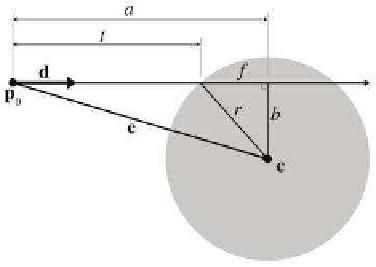Game Development Reference
In-Depth Information
Figure A.8
Intersection of a ray and sphere
Now we project
e
onto
d
(see Section 2.11.2). The length of this vector is
a, and can be computed by
a =
e
d
.
Now all that remains is to compute f. First, by the Pythagorean theo-
rem, we clearly see that
f
2
+ b
2
= r
2
.
We can solve for b
2
by using the Pythagorean theorem on the larger triangle:
a
2
+ b
2
= e
2
,
b
2
= e
2
− a
2
,
where e is the distance from the origin of the ray to the center, that is, the
length of the vector
e
. Thus, e
2
can be computed by
e
2
=
e
e
.
Substituting and solving for f, we get
f
2
+ b
2
= r
2
,
f
2
+ (e
2
− a
2
) = r
2
,
f
2
= r
2
− e
2
+ a
2
,
r
2
− e
2
+ a
2
.
f =
Finally, solving for t, we have
t = a − f
Parametric intersection
of a ray and a circle or
sphere
= a −
r
2
− e
2
+ a
2
.
If the argument to the square root (r
2
− e
2
+ a
2
) is negative, then the
ray does not intersect the sphere.









Search WWH ::

Custom Search